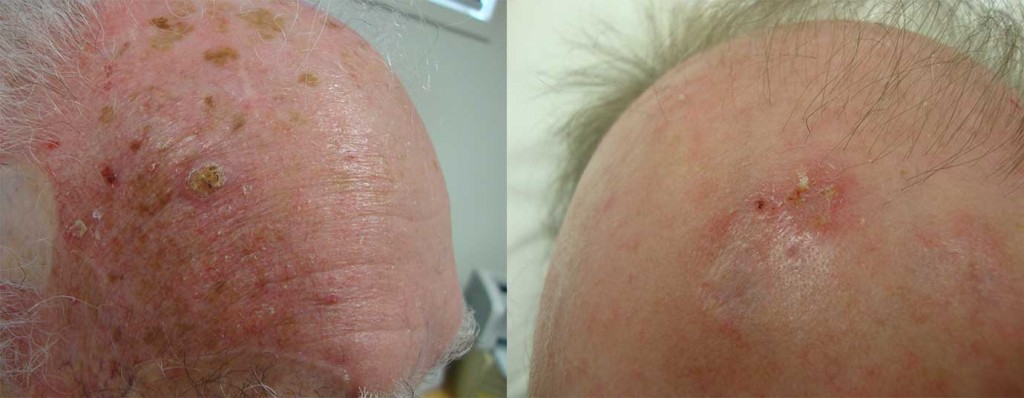Also known as…Intra-Epidermal Squamous Cell Carcinoma
Squamous cell carcinoma (SCC) is one of the most common forms of skin cancer, with only basal cell carcinoma (BCC) occurring more frequently. SCC occurs mainly in Caucasians. It starts from cells in the outermost layer of the skin which start to overgrow and potentially spread. SCC can also start from cells on the lips, tongue, lining of the mouth and genitals.

SCC is caused mainly by chronic sun exposure. It is thought that the ultraviolet light, particularly UVA, from the sun gradually triggers the skin cells into developing into a SCC. This means that most SCCs occur on sun-exposed sites and usually in older individuals. SCC is very rare in children and young adults.
Sometimes a wart virus can trigger changes in the cells causing a SCC to form, especially on the genitals or inside the mouth. Other cases are caused by exposure to chemicals (such as arsenic or the tar found in cigarette smoke) or due to trauma such as a burn. People who are immunosuppressed such as those who have had an organ transplant or those with conditions such as lymphoma are more prone to developing multiple SCCs.
SCC can present in many different ways. It often presents as a raised scaly lump on sun-exposed sites commonly found on the backs of the hands, forearms, legs, scalp, ears and lips. SCCs can also appear as a crusted sore. On the lips an SCC can present as a persistent small ulcer or thickened firm scaly skin.

SCC can develop slowly over years from a red scaly sun spot that slowly thickens and enlarges, to become an intraepidermal carcinoma (Bowen’s disease) which is SCC in the thin top layer of the skin. This may progress further to become a fully developed SCC involving the deeper layers of the skin.

SCC can also develop rapidly with the changes occurring over a few months.
While most SCCs are easily treated and don’t cause any future concerns there are some potential problems. SCCs have the potential to spread to the lymph nodes and onto other organs.
Every year people die from more aggressive SCCs. SCCs with the potential to cause problems are those occurring on the lip, ear and scalp; those over 2cm in diameter; and those showing growth around nerves or with a more aggressive pattern under the microscope.
The diagnosis is usually suspected by a dermatologist based on the appearance or behaviour of the SCC. However, a small biopsy is often needed to confirm the diagnosis prior to treatment being undertaken. The biopsy helps avoid unnecessary surgery on a benign lesion that may mimic SCC and also determines the type of SCC and subsequent treatment method.
The condition is usually treated with simple skin surgery. This enables the pathologist to check under the microscope that the SCC has been removed completely. Further surgery or radiation therapy may be required if there was any residual tumour evident, or nerves were involved or a more aggressive pattern was seen under the microscope.
Cemiplimab (immunotherapy agent) has been approved in Australia for use by oncologists for metastatic or locally aggressive SCC.
In some situations and in some locations, small SCCs can be treated by a scraping called curettage or by freezing with liquid nitrogen. In circumstances where surgery is not appropriate the SCC may be treated by radiation therapy alone. In all these situations regular follow up will be required for monitoring.
Recent studies have shown that taking a Vitamin B3 tablet called nicotinamide daily may help lower the incidence of SCCs in high risk individuals.
This information has been written by Dr Brad Jones
Last updated: October 2022
Disclaimer
2019 © Australasian College of Dermatologists.
You may use for personal use only. Please refer to our disclaimer.